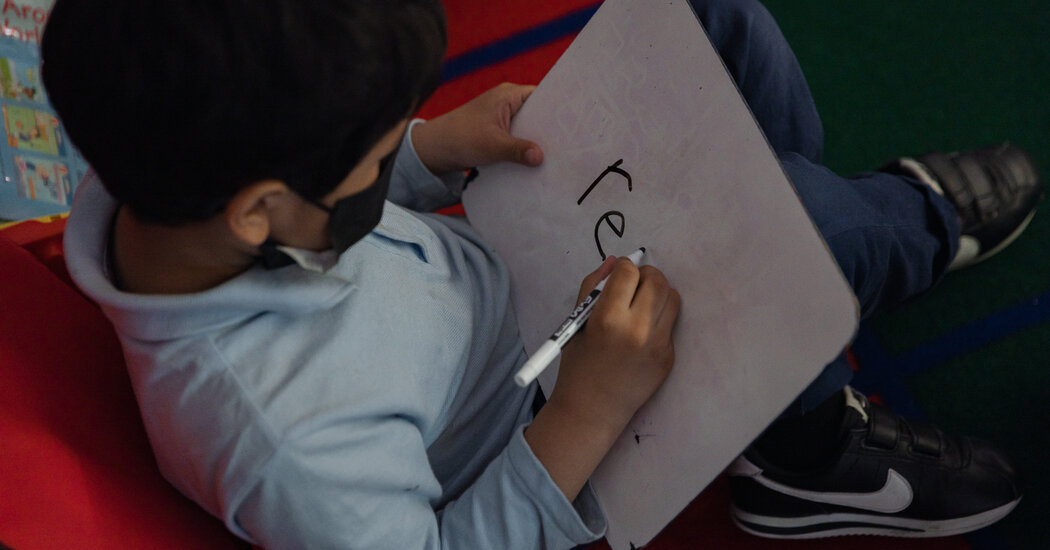When Gov. Mike DeWine of Ohio set out to overhaul reading instruction in his state this year, it seemed like another sign that the decades-long debate over how to teach reading had come to a tipping point.
Ohio joined the growing list of states that require schools to follow the “science of reading” — an approach that emphasizes systematic, sound-it-out instruction, known as phonics, and the direct teaching of other skills, like vocabulary.
The movement, fueled by longstanding research, has sought to oust “balanced literacy,” which is meant to give teachers flexibility to meet students’ needs while promoting a love of reading. It may include some phonics, but also other strategies, like prompting students to use context clues — like pictures — to discern words.
“The weight of the evidence is clear,” Mr. DeWine said in an interview this week. “My only regret is we didn’t do it earlier.”
But a recent lawsuit by the Reading Recovery Council of North America, an Ohio-based nonprofit that supports balanced literacy, is challenging the state’s new mandate — underscoring the financial and ideological forces at work in the national debate.
“I hope this is the first of many lawsuits to settle the wildly swinging pendulum that has plagued schools for decades,” Billy Molasso, the Reading Recovery Council’s executive director, wrote in a blog post, criticizing Mr. DeWine and Ohio lawmakers for succumbing to a political and media “circus” supporting the science of reading.
Reading Recovery is an intervention program aimed at helping first graders in the bottom 20 percent of their class. The nonprofit partners with universities to train teachers and school district leaders in its methods. In the 2021-22 school year, the program reached about 23,500 students in more than 600 districts nationally.
The program — whose effectiveness has recently come under scrutiny — owes much of its success in the United States to Gay Su Pinnell, a star of balanced literacy who is a professor emerita and a major donor at Ohio State University. Along with Irene C. Fountas, Dr. Pinnell wrote one of the most lucrative and popular reading curriculums used in elementary schools.
But the trend toward the science of reading has put pressure on established players in education, who believe deeply in what they do and have fought to keep their foothold in the marketplace.
In its lawsuit, the Reading Recovery nonprofit said that it had experienced “a decline in membership” in Ohio and expected fewer registrations for its annual conference, which brings in much of the group’s revenue. Tax records show that the group took in just over $1 million last year.
“The practical matter is, we have to be able to keep our business going,” Dr. Molasso said in an interview.
“But the stand is principled,” he said, adding, “We believe that what we do works, and we’ve got evidence to prove that it does work.”
The lawsuit contends that Governor DeWine violated state law by pushing a change in reading policy through in a budget bill, rather than in specific legislation.
The governor has dismissed the lawsuit as self-interested. “They are upset that they are not going to be able to make money anymore,” he told reporters after the suit was filed last month.
In daily one-on-one lessons, Reading Recovery students practice reading with coaching from a teacher. Phonics is included as needed, but it is not primary, said Dr. Molasso, who rejected what he called one-size-fits-all instruction. “We have a ‘whatever it takes’ philosophy. Sometimes that is phonics,” he said. “Sometimes it’s something else.”
Students may be taught to use context clues, including pictures, to discern a word’s meaning, a practice known as three-cueing. The practice was banned in Ohio as part of the new mandate and has been criticized by science of reading advocates for taking students’ attention away from letters on the page.
Dr. Molasso said three-cueing is used only early on, to build a child’s confidence — for example, if a student knows what an elephant looks like, but has not yet connected the oral and written words.
“It’s not a strategy we use or support later in that progression of learning how to read,” he said.
Dr. Pinnell helped bring Reading Recovery to the United States from New Zealand in the 1980s and helped establish a base at Ohio State. The university hosts one of about a dozen Reading Recovery training centers across the country.
Dr. Pinnell, who is a volunteer board member for the Reading Recovery Council, has given more than $400,000 to the nonprofit since 2013, according to tax filings, and recently donated a combined $4 million to support Reading Recovery training programs at Texas Woman’s University in Denton, Texas, and Lesley University in Cambridge, Mass.
She has also donated to Ohio State, including a $7.5 million donation in 2020 that was the largest gift by an individual in the College of Education’s history. The donation, in part, endowed a professorship that helps support Reading Recovery training at Ohio State.
(She is also a personal acquaintance of Mr. DeWine, and has supported his charity work for a school in Haiti, named for his late daughter.)
Dr. Pinnell, through a representative of her publisher, declined to comment for this article, citing the pending lawsuit. In her role on the board, Dr. Pinnell is not active in the Reading Recovery Council’s day-to-day decisions, the representative said.
Ohio State, which is not involved in the lawsuit, said that while the university was home to the training center for school districts, its undergraduate education program does not use Reading Recovery to train its future teachers.
Reading Recovery cites studies that have found positive outcomes, including a large, federally funded study in 2016 by Henry May, an associate professor at the University of Delaware, and other researchers. That study found large gains for students by the end of first grade.
But a follow-up study by Dr. May published this year found negative outcomes over a longer term. The Reading Recovery Council rejected the results, citing methodological issues.
The follow-up study, which compared students who received Reading Recovery intervention with other struggling readers who had not, found that by third and fourth grade, Reading Recovery students were as much as a full grade level behind.
The results surprised researchers, who “went back, checked, double checked, triple checked,” Dr. May said.
Timothy Shanahan, a professor emeritus at the University of Illinois at Chicago, who was not involved in the study and described it as high quality, said one theory for the negative results is that students were taught to rely on strategies that backfired as the material they were reading grew more advanced.
“Young children do start out trying to use various strategies,” he said. “If you show them a tube of toothpaste that says ‘Crest,’ they’ll guess that it says ‘toothpaste.’” But he added, “Learning to read entails giving up that strategy and focusing more on ‘How do I actually get the author’s word, and not just their general idea?’”



